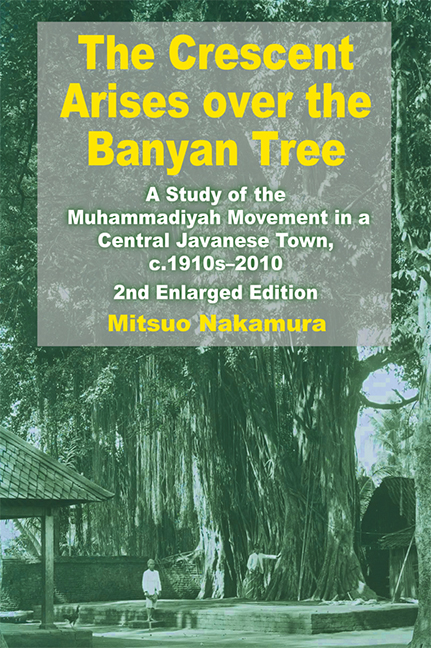 The Crescent Arises over the Banyan Tree
The Crescent Arises over the Banyan Tree Book contents
- Frontmatter
- Dedication
- Epigraph
- Contents
- List of Figures and Maps
- List of Tables
- List of Boxes
- Foreword to the Second Edition
- Preface to the Second Edition
- Foreword to the First Edition
- Preface to the First Edition
- Notes
- Map
- PART I DEVELOPMENT OF THE MUHAMMADIYAH IN KOTAGEDE, c.1910s–1972
- PART II KOTAGEDE REVISITED, 1972–2010
- Bibliography
- Glossary
- Appendices
- Index
- About the Author
Preface to the First Edition
Published online by Cambridge University Press: 21 October 2015
- Frontmatter
- Dedication
- Epigraph
- Contents
- List of Figures and Maps
- List of Tables
- List of Boxes
- Foreword to the Second Edition
- Preface to the Second Edition
- Foreword to the First Edition
- Preface to the First Edition
- Notes
- Map
- PART I DEVELOPMENT OF THE MUHAMMADIYAH IN KOTAGEDE, c.1910s–1972
- PART II KOTAGEDE REVISITED, 1972–2010
- Bibliography
- Glossary
- Appendices
- Index
- About the Author
Summary
The original version of this book is my doctoral dissertation in anthropology submitted to Cornell University in 1976. Data for the dissertation was obtained through fieldwork and archival research. The fieldwork was conducted in the town of Kotagede in the Special Region of Yogyakarta, Central Java, Indonesia, for a period of nineteen months between October 1970 and April 1972. The archival research of two and a half months was carried out in the Netherlands between June and August 1972.
In this book I attempt to present a history and an ethnography of a local branch of the Muhammadiyah movement, one of the most influential Islamic movements in contemporary Javanese society. My perception of Islam in Java in general, and of the Muhammadiyah movement in particular, changed markedly through my field experience. Before fieldwork, I thought that Islam in Java was a losing religion: Javanese Muslims were politically divided and weak, economically stagnant, ideologically conservative, and culturally dull in spite of their numerical strength; Islam as a religion concerned only a small proportion of the Javanese population, a particular segment which was commonly referred to as santri in recent social science literature. Personal encounter with Islam and Muslims through fieldwork has changed my perception: Islam in Java is by no means a waning religion but a vital living faith providing guidelines for ethics and inspiration for aesthetics; the Islamization of Java is not a completed historical event but an ongoing process; the Muhammadiyah represents part of this process of continuing Islamization; Islam concerns not a particular segment of Javanese society but its entire population in that it constitutes an integral part of Javanese religious traditions. This book is thus, in a sense, a testimony for the ‘conversion’ of my view on the significance of Islam in Javanese society. But, at the same time, it is my hope that this book will also contribute to providing some empirical answers to questions often asked about Islam in Java: To what extent and in what ways are the Javanese Muslims? And why is it that Islam still persists in Java?
In revising the original dissertation for publication, I have tried not to be tempted to produce an entirely new work.
- Type
- Chapter
- Information
- The Crescent Arises over the Banyan TreeA Study of the Muhammadiyah Movement in a Central Javanese Town, c.1910s-2010 (Second Enlarged Edition), pp. xxxix - xlivPublisher: ISEAS–Yusof Ishak InstitutePrint publication year: 2012
